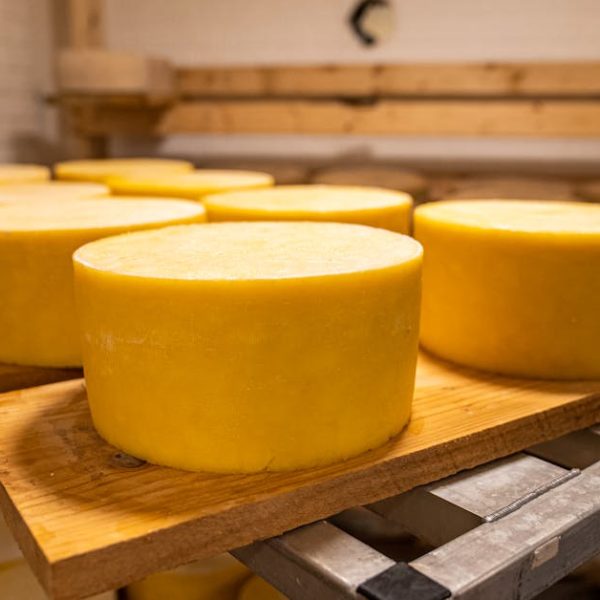Whether you bought a whole block of cheddar only to realize you cannot finish it in time or you simply want to preserve your cheese to savor it longer, understanding the specifics concerning cheddar cheese’s shelf life and preservation methods is essential.
Understanding Cheddar Cheese’s Shelf Life
The natural shelf life of cheddar cheese depends on a number of factors including its fat content, age, and packaging. Higher fat content generally leads to a longer shelf life, while the cheese’s age can go both ways. Younger cheddars tend to spoil faster while more aged varieties can last quite a while. The packaging also plays a critical role. Cheeses packed in vacuum-sealed plastic tend to maintain their freshness for longer compared to those that are merely wrapped in plastic.
Here’s a quick rundown of the average shelf lives for different types of cheddar:
- Matured cheddar: 5-6 months
- Vintage cheddar: 7-8 months
- Smoked cheddar: 6-7 months
Pro Tip: If you’re uncertain about the freshness of your cheddar, check for signs of spoilage. These can include an off smell, mold, or a dry and crumbly texture.
The Impact of Storage Conditions on Cheddar’s Freshness
The conditions under which you store your cheddar cheese can dramatically affect its freshness and taste. Factors such as temperature, humidity, and light exposure can all impact how long your cheddar remains good for.
Consider the difference between these storage conditions:
| Proper Storage | Improper Storage |
|---|---|
| Stored in a cool, dark place | Left in a warm, brightly lit location |
| Stored at a consistent temperature | Exposed to fluctuating temperatures |
| Wrapped in wax paper or cheese paper | Wrapped in cling film or plastic bag |
Best Practice: To keep your cheddar fresh, ensure it’s stored in a consistently cool spot, with a temperature below 8 degrees Celsius. The cheese should be wrapped in something breathable, like wax or cheese paper, and kept away from strong odors as cheese is very good at absorbing them.
Preservation Methods to Extend Cheddar Cheese Shelf Life
For long term storage, enforcing preservation techniques like waxing, vacuum sealing, and freezing can significantly extend cheddar cheese’s lifespan.
A checklist for each preservation method might include:
- Waxing: cheese wax, brush, double boiler
- Vacuum sealing: vacuum sealer, vacuum seal bags
- Freezing: freezer, plastic wrap, freezer bags
Of course, each preservation method has its own pros and cons. For instance, waxing requires some equipment and skill, but it allows the cheese to breathe while still providing protection. Vacuum sealing is excellent for preventing mold growth, but it might change the texture of the cheese. Freezing is the easiest method, but the quality of the cheese might be significantly altered when thawed.
Understanding these factors will help you determine the best preservation method to suit your specific needs.
Do’s and Don’ts When Handling Cheddar Cheese to Keep It Fresh
Optimal handling practices can dramatically affect the freshness and enjoyability of your cheddar cheese. Here are some crucial do’s and don’ts that can make a significant difference:
Do’s:
- Always handle your cheddar cheese with clean utensils to avoid bacterial contamination.
- When cutting, start from the center and move outward towards the edge to reduce exposure of cheese to air.
- After serving, promptly return leftover cheese to the refrigerator.
Don’ts:
- Don’t let your cheese come into contact with other strongly scented foods, as cheese tends to absorb the odors.
- Avoid touching the cheese with bare hands to minimize bacterial contamination.
- Don’t leave cheese unwrapped as it can lead to drying out or absorbing unwanted flavors.
Best Practice: Always remove your cheese from the fridge about an hour before serving. This not only brings out the full flavor of the cheese but also prevents ‘sweating’ – the release of condensation when a cold cheese hits a warm room.
Maintaining Cheddar Quality and Taste After Preserving
Preservation techniques can have an effect on the taste and texture of cheddar cheese. Luckily, with careful handling, these changes can be minimized.
Pro Tip: If you choose to freeze your cheddar, slowly thaw it in the refrigerator (rather than at room temperature) to limit changes in texture and help maintain its original quality.
Despite these changes, it’s still important to serve your cheese properly to ensure the best flavor.
Best Practice: Always serve and consume cheddar at room temperature – this will allow the complex flavors of the cheese to shine, giving you and your guests the full cheddar experience.
By keeping these tips in mind, you can enjoy your cheddar to the fullest, whether it is enjoyed fresh or after long term storage. It’s all part of savoring the rich, tantalizing world of cheese!
Key Takeaway:
- Cheddar cheese’s shelf life is dependent on factors such as fat content, age, and packaging material with average shelf lives for different types of cheddar ranging from 5-8 months. Signs of spoilage include off smell, mold, or a dry and crumbly texture.
- Proper storage conditions, maintaining a constant temperature beneath 8 degrees Celsius in a cool, dark place, greatly influence the freshness and taste of cheddar cheese.
- Preservation methods (waxing, vacuum sealing, and freezing), bear both advantages and disadvantages, and understanding these can help to extend the shelf life of cheddar dramatically.
- Optimal handling practices and best practices (not touching cheese with bare hands, serving at room temperature) play a significant role in maintaining the freshness, quality, and taste of cheddar cheese.
Cheese might be a complex topic, but it’s also an enticingly delicious field to explore. Mastering the basic knowledge about cheddar cheese’s shelf life, storage conditions, and preservation techniques can significantly enhance your cheese experience. So, enjoy your cheddar journey and remember – cheese is meant to be savored, cherished, and enjoyed.
FAQs
Q: Does cutting cheddar cheese impact its shelf life?
A: Yes, once cut, cheddar cheese’s exposure to air increases which can speed up the process of spoilage. To ensure it stays fresh for longer, always wrap the cut cheddar properly before storing.
Q: Can I store multiple types of cheeses together?
A: It’s generally not recommended as cheese can absorb flavors and smells from other types of cheese, which can adversely affect their original taste.
Q: Should I discard the whole cheese if I see a small area of mold?
A: It depends. You can safely cut away the moldy part and consume the rest of the cheese. However, if mold has spread extensively, it is better to discard the entire cheese product.
Q: Can I freeze cheddar cheese and how does it impact its taste and texture?
A: Yes, you can freeze cheddar cheese. However, this might change its texture, making it more crumbly. The taste usually remains the same, but it is best served at room temperature after thawing gradually in the refrigerator.
Q: What should I do if my cheddar cheese sweats?
A: Sweating in cheese is natural as it adjusts to room temperature, while its fat starts to melt. Simply blot away the moisture with a paper towel. It’s crucial to not serve cheese straight from the fridge to avoid this.
Feel free to explore more such informative articles on our website and don’t hesitate to share the knowledge around. Happy cheese tasting!





